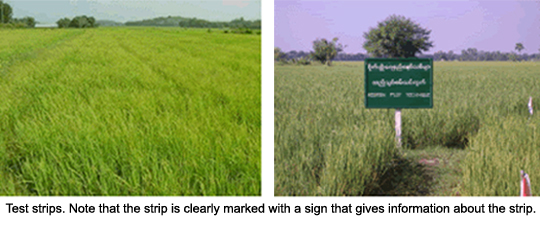Test strips
What is a test strip?
It is a strip across a farmer's field where one input is changed (either added, omitted or modified). Treatments within the strip may include a change in planting density, a new variety, or changes in fertilizer or pest management, etc... Test strips can be used for both farmer- or researcher-led field demonstrations.
Why have test strips?
Test strips are simple to highly visible. It is easy to apply and it offers a simple way to assess a treatment relative to the farmers current practice and circumstances. The strip plots are useful tools during field days for demonstrating “new” options for farmers.
To establish test strips:
- Place adjacent to a road or point of high visibility for easy comparison with current farmers' practices.
- Make sure the part of the field is representative of the field (and the district).
- A 5 m wide strip across a field is generally adequate.
- The whole field (including the strip) is managed by the farmer.
- Test strips are best interpreted when there is a single treatment per strip.
- Place a sign outlining the treatment and who to contact for more information.
Limitations of Addition Plots
- If the part of the field receiving the treatment is not representative for the rest of the field or region, conclusions on treatment performance may be incorrect.
- Test strips can only be used to highlight the effect of one treatment at a time.








